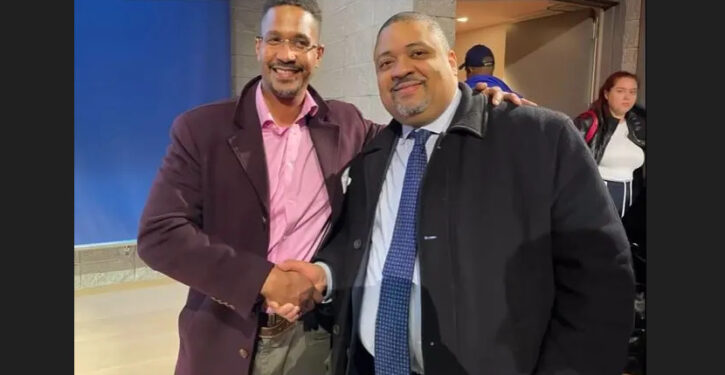
“Youth gun crime statewide has doubled—and youth gun victimization has nearly tripled” in New York after it passed the “Raise the Age law, which significantly scaled back punishments for 16- and 17-year-old criminal offenders,” notes City Journal. Most of the victims killed or injured are people of color. But criminal justice reformers are undaunted by the rise in crime and recidivism rates. They want to make the criminal justice system even softer on crime. They view tough-on-crime policies as racist, because most of the people doing the shootings are people of color, and they think it is racist to punish people of color for crimes committed in a society where stark racial disparities exist:
When David Soares was elected district attorney in 2004 in Albany County, New York, he enjoyed united support on the left; even the radical Working Families Party had endorsed him. A childhood immigrant from Africa, Soares doesn’t lack for “lived experience.” Over nearly 19 years in office, he’s consistently backed progressive criminal-justice reforms. But Soares is now demoralized, seemingly near tears when he tells me that no one will talk about the victims of violence, who—in Albany, as in New York City—are disproportionately young black men.
As DA, Soares has seen firsthand the role that 2017’s Raise the Age law, which significantly scaled back punishments for 16- and 17-year-old criminal offenders, played in worsening crime. Since that law passed, youth gun crime statewide has doubled—and youth gun victimization has nearly tripled. About 75 percent of violent felony cases now get handled in family court, which returns teens to the streets, where they often commit new crimes or become victims themselves of tit-for-tat gang warfare. “We witnessed the murder of a young man at the hands of another young man that had gone through the family court Raise the Age process . . . a minimum of three times,” Soares told local legislators in July. “This was a system that was never designed to handle or deal with violent—super, super violent—youth.”
Legislators have responded to his alarm with vitriol. Earlier this year, the New York State Senate’s counsel disinvited Soares from testifying at a hearing, worried that he (a black man) would talk about black crime victimization. Agency leaders, journalists, and reform advocates have denounced him for highlighting the concentration of violence in black communities and the role of misguided laws in enabling it.
Perhaps even more disheartening for Soares are calls from prominent leaders, who thank him for speaking out—but refuse to do so themselves….But for true-believer progressives, who wield tremendous political influence, certain ways of evaluating crime policies are viewed with genuine contempt: pointing to the unintended negative consequences of reforms, stressing the need to use data to evaluate policies, and acknowledging how individual accountability and culture play vital roles in crime prevention.
To make matters worse, these officials have the savvy not to acknowledge publicly the depth of their contempt for data, culture, and life-and-death crime realities. In private discussions, they averred to me that no amount of violent fallout in the black community will persuade them to amend a policy that pursues their goals of funding more social services and eviscerating the criminal-justice system. Tellingly, however, the progressive leaders interviewed for this article were unwilling to publish their guiding beliefs on the record. Therefore, representative, anonymized quotes appear below….
Many …. are aware of the realities of crime, but they adhere to an ideological position that crime is a response to an unjust, racist society and that the public-safety solution should thus involve social services—housing, employment, and education—combined with a scaling-down, if not abolition, of the criminal-justice system.
“Jonathan,” a progressive former New York City court program head, perfectly expresses this point of view: “The state has harmed communities, taken their resources.” Rather than discussing forbidden topics [like the need to incarcerate dangerous offenders], he says, we should ask: “What would make these conditions never exist?….health care… public programs. . . . That’s the conversation I want to have around crime victimization.”…
Is there a successful model of replacing criminal justice with social services? An influential progressive agency head, “Jones,” is adamant: if no jurisdiction in this country has yet achieved public order this way, we just need to try harder and wait longer….
Meantime, overwhelming evidence suggests that law enforcement reduces crime….But this is the kind of data-based evaluation that progressives believe obscures deeper truths about the relationship between social or economic disadvantage and crime. Jonathan dismisses quantitative analyses….“I get annoyed with evidence blah blah blah.”
Jones, too, believes that research isn’t instrumental for policy discussions, as it fails to capture the emotional experiences of individuals who “didn’t make it into the study.” For Jones, this felt experience—the infliction of a racist America—nullifies personal agency and accountability. “It’s very difficult to separate out what a 17-year-old black young man is thinking and his personal accountability when he feels hopeless, which is how this country wants him to feel.”
To justify soft-on-crime policies, “criminal justice reform” groups like FAMM routinely make false statistical claims that are obviously wrong, about the effects of incarceration. “People age approximately three times faster in prison,” says Maria Goellner, director of state policy at FAMM (formerly Families Against Mandatory Minimums).” In reality, incarceration has surprisingly little effect on people’s life spans. Studies sometimes find that criminals actually live longer in prison than they do in the outside world.
A recent peer-reviewed study in the American Economic Journal finds criminals have lower mortality rates in prison than they do outside of prison. That study, titled “The Health Effects of Prison,” found that when prisoners have to serve more time before being released,
The increased time served did not harm post-release health and actually reduced mortality risk. We find especially large decreases in mortality for offenders not previously incarcerated, younger offenders, and those more attached to the labor market. Risk of suicide and circulatory death fell for inmates with mental health problems and older inmates, respectively.
Criminals do not have particularly long life spans. But going to prison actually curbs some of criminals’ self-destructive behaviors, enabling many of them to live longer.
Why do groups like FAMM make false claims about inmates dying early due to incarceration? They do it in order to lobby for laws releasing inmates early, such as legislation lowering the age of geriatric release to age 50 (as Virginia’s Democratic Governor Ralph Northam proposed in 2020 for many inmates). If inmates really did age three times faster in prison than in the outside world, they would be close to death by the time they hit age 50, and not very dangerous to release. But in reality, there are inmates over age 60 in prison — enough that they are a category regularly studied by law enforcement. For example, in 2022, the U.S. Sentencing Commission issued a report finding that over an eight-year period, violent offenders returned to crime at a 63.8% rate after being released from prison. It found that even among those over age 60, 25.1% of violent offenders were rearrested for new crimes.
Admittedly, many of these elderly inmates are there for crimes committed when they were already old. As progressive professor John Pfaff notes, “Among prisoners who are over 65, fully half have served fewer than 10 years, which means they were admitted in their mid- to late 50s” for things such as “late-age violence…One study also suggests that extensive drug use when younger has led to higher levels of crime among a cohort of older Americans.”
Even inmates who are no longer young tend to commit more crimes after being released. Nationally, 81.9% of all state prisoners released in 2008 were subsequently arrested within a decade, including 74.5% of those 40 or older at the time of their release. (See Bureau of Justice Statistics, Recidivism of Prisoners in 24 States Released in 2008: A 10-Year Follow-Up Period (2008-2018), pg. 4, Table 4).
Yet, Daniel Landsman, a FAMM lobbyist who supports legislation to release murderers early, falsely claimed on January 15 that “Once an individual reaches their 40s and 50s, the likelihood of offending is small and approaching zero.” Landsman made this claim in written testimony in support of HB 1325, a “second look” bill in Washington State. 74.5% of inmates over age 40 reoffending is not “small and approaching zero,” Mr. Landsman.
The data from the U.S. Sentencing Commission contradicts claims made by FAMM and other “criminal justice reform” groups, such as the Law Enforcement Action Partnership (LEAP), which is funded by left-wing billionaire George Soros‘ foundation. LEAP has mistakenly claimed that keeping people in prison who were sent there “a decade ago” does “very little, if anything, to maintain safety,” even though most inmates released after a decade in prison are arrested for new offenses.
“A murderer was released early, celebrated by soft-on-crime groups, then charged with two more killings. Tragic and completely avoidable,” noted Senator Tom Cotton. “FAMM Foundation…praised the convicted murderer,” Steven Hawthorne. “They argued that ‘more [prisoners serving long sentences] need the same chance.’ Groups like FAMM won’t have empathy for the victims. Only for the killers,” Cotton observed.
Criminal justice reform groups routinely claim that incarceration does not make us safer. But in the real world, big increases in incarceration seem to lead to reductions in crime. When El Salvador dramatically increased its incarceration rate, its murder rate fell from being “the world’s highest” to a much lower, safer level. (See Kejal Vyas & Santiago Perez, The Country With the Highest Murder Rate Now Has the Highest Incarceration Rate, Wall Street Journal, July 10, 2023).
Some criminal justice reformers are criminals who go on to commit more crimes. A criminal justice reformer was recently arrested for murder after dismembered body parts were found in his apartment. Since the death of George Floyd, there has been an explosion in the number of “criminal justice reform” groups, many of which support abolishing prisons and the police. Taxpayers and big foundations support many of these groups.
As Swann Marcus observes, “There are state funded police abolitionist nonprofits with sex criminals and convicted murderers on the board and unsurprisingly they often go on to offend again. There’s an NGO called Freedom Project in Seattle that had a convicted murderer staff member commit another murder.” “When I say “staff member” I mean he was hired for an executive position like 8 months after getting out of prison for homicide. Their current Operations Director, Aretha Sconiers, “went to prison in 2001 for kicking her 3 year old daughter to death.”
A criminal justice reformer who helped pass legislation to release inmates early was later arrested for “beating his wife on numerous occasions and inflicting injuries that required treatment at a hospital,” reported the National Law Journal. Shon Hopwood — a member of FAMM’s Board of Directors — was the “poster child” for early releases of inmates, having gone from being an imprisoned bank robber, to later becoming a prominent law professor. “He played a role in the passage of the landmark criminal justice reform bill known as the First Step Act.” Hopwood allegedly broke his wife’s finger and tooth. “I received bruises all over my body,” his wife said in an affidavit. He also allegedly had a history of cruelty toward animals and siblings.



